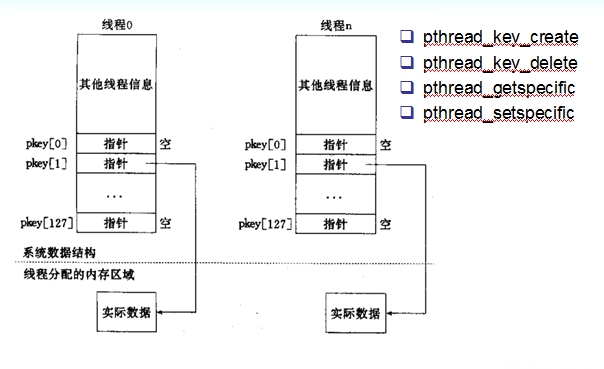linux 线程私有数据之 一键多值技术 进程内的所有线程共享进程的数据空间,因此全局变量为所有线程所共有。但有时线程也需要保存自己的私有数据,这时可以创建线程私有数据(Thread- specific Date)TSD来解决。在线程内部,私有数据可以被各个函数访问,但对
linux 线程私有数据之 一键多值技术
进程内的所有线程共享进程的数据空间,因此全局变量为所有线程所共有。但有时线程也需要保存自己的私有数据,这时可以创建线程私有数据(Thread- specific Date)TSD来解决。在线程内部,私有数据可以被各个函数访问,但对其他线程是屏蔽的。一个明显的例子是errno,每个线程都有自己的副本,不然由于线程间的切换,在一个线程里输出的很可能是令一线程的出错信息。

线程私有数据采用了一种一键多值的技术,即一个键对应多个数值。访问数据时都是通过键值来访问,好像是对一个变量进行访问,其实是在访问不同的数据。使用 线程私有数据时,首先要为每个线程数据创建一个相关联的键。POSIX中操作线程私有数据的主要通过以下4个函数来实现:pthread_key_create(创建一个键),pthread_setspecific(为一个键设置线程私有数据),pthread_getspecific(从一个键读取线程私有数据),pthread_key_delete(删除一个键)。这几个函数的声明如下:
int pthread_key_create(pthread_key_t *key, void (*destr_function) (void*));
int pthread_key_delete(pthread_key_t key);
int pthread_setspecific(pthread_key_t key, const void *pointer);
void * pthread_getspecific(pthread_key_t key);
pthread_key_create:从Linux的TSD池中分配一项,将其值赋给key供以后访问使用,它的第一个参数key为指向键值的指针,第二个参数为一个函数指针,如果指针不为空,则在线程退出时将以key所关联的数据为参数调用destr_function(),释放分配的缓冲区。
key一旦被创建,所有线程都可以访问它,但各线程可以根据自己的需要往key中填入不同的值,这就相当于提供了一个同名而不同值的全局变量,一键多值。一键多值靠的是一个关键数据结构数组,即TSD池其结构如下:
static struct pthread_key_struct pthread_keys[PTHREAD_KEYS_MAX] ={{0,NULL}};
创建一个TSD就相当于将结构数组中的某一项设置为“in_use”,并将其索引返回给*key,然后设置destructor函数 destr_function。pthread_key_create 创建一个新的线程特定数据Key时,系统搜索其所在进程的 Key 结构数组,找出其中第一个不在使用的元素,并返回该元素的索引键。
pthread_setspecific:该函数将pointer的值(不是内容)与key相关联。用pthread_setspecific为一个键指定新的线程数据时,线程必须先释放原有的线程数据用以回收空间。
pthread_getspecific:通过该函数得到与key相关联的数据。
pthread_key_delete:该函数用来删除一个键,键所占用的内存将被释放。需要注意的是,键占用的内存被释放,与该键关联的线程数据所占用的内存并不被释放。因此,线程数据的释放必须在释放键之前完成。
下面我们通过一个例子来学习使用这几个函数的使用,功能类似errno在线程的使用,我猜想全局变量errno是在创建一个线程pthread_create时利用TSD池为该线程分配一个errno的副本的。
点击(此处)折叠或打开
/* my_errno.c
编译链接:gcc my_errno.c -o my_errno -lpthread
*/
// 线程私有数据,一键多值,tsd池
#include <stdio.h>
#include <string.h>
#include <pthread.h>
int my_errno = 0;
pthread_key_t key;
void print_errno(char *str)
{
printf("%s my_errno:%d\n",str, my_errno);
}
void *thread2(void *arg)
{
printf("thread2 %ld is running\n",pthread_self());
pthread_setspecific(key, (void *)my_errno);
printf("thread2 %ld returns %d\n",pthread_self(),\
pthread_getspecific(key));
my_errno = 2;
print_errno("thread2");
}
void *thread1(void *arg)
{
pthread_t thid2;
printf("thread1 %ld is running\n",pthread_self());
pthread_setspecific(key, (void *)my_errno);
pthread_create(&thid2, NULL, thread2, NULL);
sleep(2);
printf("thread1 %ld returns %d\n",pthread_self(),\
pthread_getspecific(key));
my_errno = 1;
print_errno("thread1");
}
void destr(void *arg)
{
printf("destroy memory\n");
}
int main(void)
{
pthread_t thid1;
printf("main thread begins running. my_errno=%d\n",my_errno);
pthread_key_create(&key, destr);
pthread_create(&thid1, NULL, thread1, NULL);
sleep(4);
pthread_key_delete(key);
printf("main thread exit\n");
return 0;
}
./my_errno 后你会发现虽然my_errno是全局的,但在thread1与thread2保留的是私有数据。




















 504
504











 被折叠的 条评论
为什么被折叠?
被折叠的 条评论
为什么被折叠?








